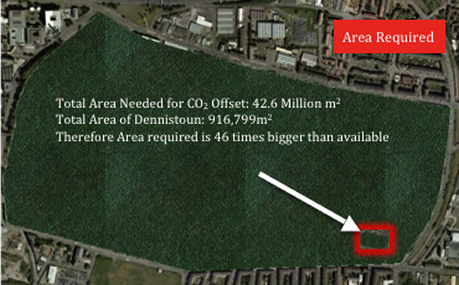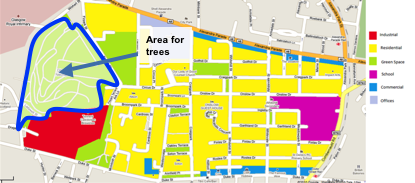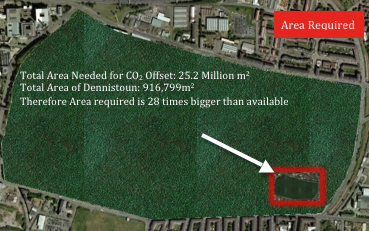There are many forms of carbon capture, probably the most common is the use of trees as carbon sinks. The total CO2 released by the area for the year is 63979.16 tonnes(link). Although trees are a very good form of carbon capture and storage, the amount they capture at a best estimate is 15 tons of CO2 per hectare per year. This figure was decided on due to the lack of consensus on the capturing potential of a hectare of trees and this is the best case value. Therefore for the area of Dennistoun to offset all the CO2 produced by its inhabitants it would need to cover 45 times the size of Dennistoun with the best CO2 capturing trees (Figure 1).

Figure 1 : Tree Offset for Dennistoun.
This is quite an unrealistic option due to the amount of land that would be required and the non-transferability of the option (although the planting of trees should not be discounted altogether, the project team felt other areas held more promise). If the whole area of Dennistoun (916,799.00m2) was to be uprooted and then covered with trees it would only offset 1,375.2 tons of CO2 per year, but once again this is an unrealistic option.

Figure 2: The area chosen for the majority of trees
What was the best solution was to cover the large area of green space in the community with trees as this area was uninhabited and available for planting (figure 2). The main calculations can be seen in table one.
Area to be covered (m2) |
130,510 |
Trees CO2 offset per hectare (10000m2) per year |
15 |
Total offset (tons of CO2 per year) |
195.77 |
Table 1: The calculations for trees.
This is a small percentage of the total areas consumption at only 0.31%. But the area it is really strong in is the economics.
Amount of stems per hectare on average |
500 |
Cost of a Norway Pine per 1000 (£) |
324.28 |
Cost of hand planting per hectare |
277 |
Total amount of stems in forest |
6525.50 |
Total Cost (£) |
5731.23 |
Table 2: Economics of Trees
This gives a very low cost of £1.46 per kilogram of CO2 saved over the 20 year period.
After all the savings of all the schemes the total amount of carbon dioxide left to be offset was 37,780 tons of CO2 per year.
It can be seen now that the area required to totally offset the new value of CO2 is nearly half as big as it was before. What’s probably more informative is looking at how much has been reduced from the areas that the schemes focused on. The total amount in the domestic and industrial areas was 36,925.80 tonnes before and after all the schemes it was reduced by 71%.

Figure 3: The new area offset by the trees